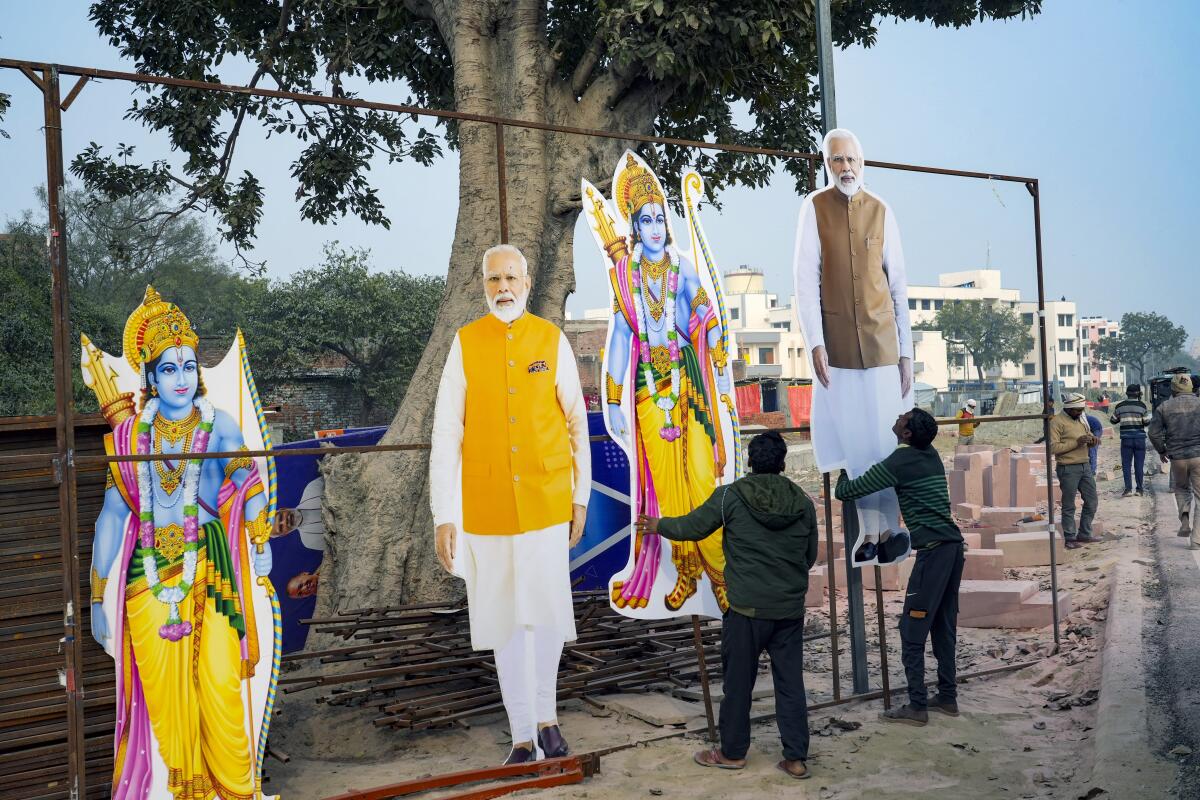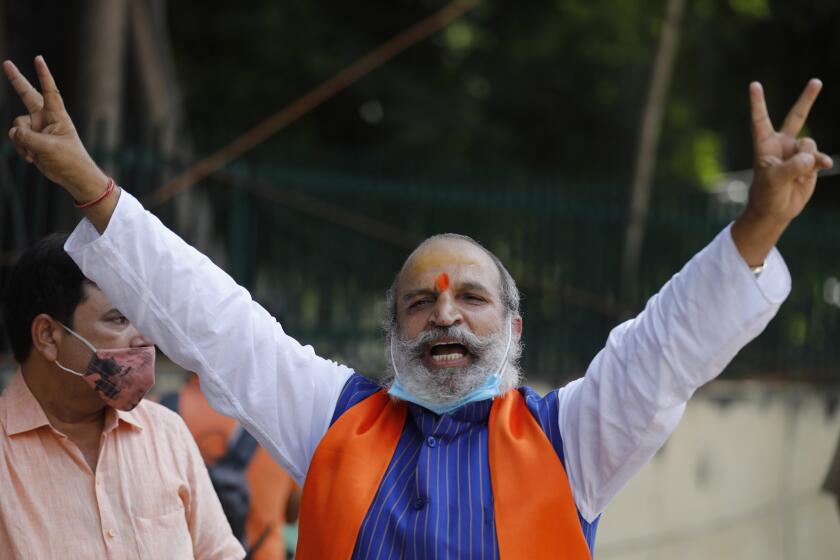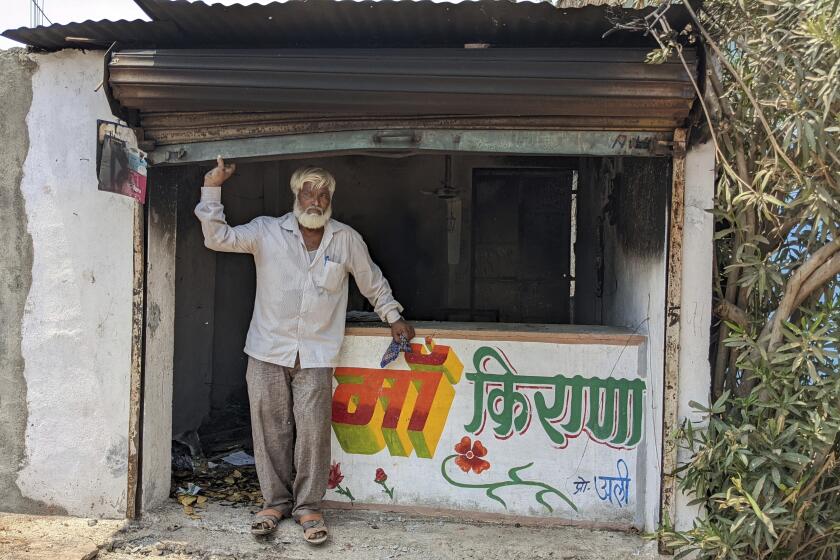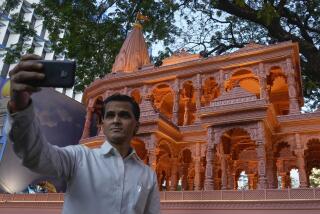A massive Hindu temple has just opened in India. Why is it so controversial?

- Share via
AYODHYA, India — About 80 chartered flights have landed at the new international airport in India’s holy city of Ayodhya for Monday’s partial opening of a controversial temple dedicated to one of Hinduism’s most revered deities, Lord Ram.
The grand temple was built over a razed mosque, and most political opposition leaders are boycotting the temple’s opening, saying it doesn’t befit a secular India.
However, the attendees are some of India’s most influential people: Prime Minister Narendra Modi, industrialists Mukesh Ambani and Gautam Adani, and Bollywood superstar Amitabh Bachchan.
Ahead of the upcoming general election, Modi’s Hindu nationalist party is using the elaborate consecration ceremony to appeal to the country’s Hindu majority.
The legend of Ram, the prince of Ayodhya
The temple will be the sacred abode of one of the Hindu pantheon’s most popular gods, Ram, who Hindus believe was born at the site in Ayodhya.
Millions of Hindus worship Ram with an intense belief that chanting his name in times of adversity will bring peace and prosperity, and most of those who practice Hinduism keep figures of Ram in their homes. Major Hindu festivals like Dussehra and Diwali are associated with mythological tales of Ram extolling the virtues of truth, sacrifice and ethical governance.
An Indian court has acquitted 32 people accused of crimes in the 1992 demolition of a mosque that sparked riots in which 2,000 people were killed.
The mythological Hindu epic “Ramayan,” which tells the story of Ram’s journey from prince to king, has often been adapted in popular culture. One of the most-viewed shows in Indian history is the TV series “Ramayan,” which was created in the 1980s and continues to have a devoted audience.
Ram’s divinity is not only a dominant religious force in India but also part of the cultural heritage in countries such as Thailand, Indonesia, Myanmar and Malaysia.
Spread over nearly 7½ acres, the temple, which is still being completed, has an estimated cost of $217 million. It’s made with pink sandstone, adorned with intricate carvings and has 46 doors — 42 of which will have a layer of gold.
Anil Mishra, a member of the trust overseeing the construction, said the temple blends traditional design with cutting-edge technology and is “crafted without the use of iron, steel or cement.”
A dark 4-foot stone sculpture depicting Ram was installed in the temple’s inner sanctum for Monday’s consecration. The religious ritual of Pran Pratishtha, which signifies giving life to the idol, will be conducted according to Hindu Vedic scriptures. The deity can then receive and bless devotees.
After the ceremony, the temple will open to the public, and an estimated 100,000 devotees are likely to visit daily, authorities say.
India’s hard-line Hindu nationalists have long espoused an anti-Muslim stance, but attacks against the minority community have been more frequent.
Ayodhya, past and present
The city, known for narrow lanes crowded with Hindu pilgrims and shops selling miniature Ram idols, has been given a facelift with modern infrastructure and services. Ayodhya’s modest airstrip has grown into an expansive international airport with a 1.4-mile runway in the first phase. The clean railway station has a daily passenger capacity of about 50,000.
“The historical and spiritual significance of Ayodhya makes it a compelling destination,” and a huge surge in demand is anticipated, said Ravi Singh, a representative of the Indian Hotels Company Ltd.
The controversy
Ayodhya has been at the center of India’s turbulent politics and the Hindu majoritarian quest to redeem the country’s religious past for decades. Its diverse, multicultural history was overrun by strident Hindu nationalism after mobs demolished the 16th century Babri mosque in 1992.
Hindus won a prolonged legal battle in 2019, allowing them to build the temple. Hindus make up about 80% of India’s population, but the country is also home to some 200 million Muslims, who have frequently come under attack by Hindu nationalists.
Modi has been the face of an unprecedented — and unapologetic — fusion of religion and politics in India and led the temple’s groundbreaking ceremony in 2020.
Critics say the idea of a diverse, constitutionally secular state leading a Hindu religious ritual is deplorable. Most opposition leaders have declined the invitation, saying the event is being used for political campaigning by Modi’s Bharatiya Janata Party, which promised to build a Ram temple as part of its election strategy.
Modi has asked people to publicly celebrate the consecration by lighting lamps at homes and temples. The message is clear: Mobilization of Hindu voters will be a key issue in the upcoming national election as Modi looks to extend his rule for a record third consecutive term.
More to Read
Sign up for Essential California
The most important California stories and recommendations in your inbox every morning.
You may occasionally receive promotional content from the Los Angeles Times.














